#stephan's quintet
Photo

Stephan's Quintet
#Astronomy#NASA#Night#Sky#Stars#Space#Science#Universe#Cosmos#Cosmic#Solar System#Stephan's Quintet#Galaxies#Galaxy#Nebula#Constellations#Constellation#Rainbow#Bright
2K notes
·
View notes
Text

Stephan's Quintet (right) and the NGC 7331 Group (left) // Cyg
#astronomy#astrophotography#galaxy group#Stephan's Quintet#NGC 7331 Group#galaxy#spiral galaxy#star-forming galaxy#interacting galaxies#NGC 7317#NGC 7318#NGC 7319#NGC 7320#NGC 7331#NGC 7335#NGC 7336#NGC 7337#NGC 7340#pegasus
59 notes
·
View notes
Text


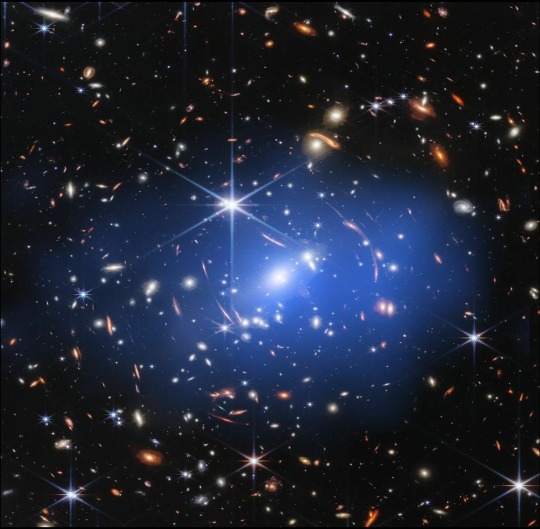
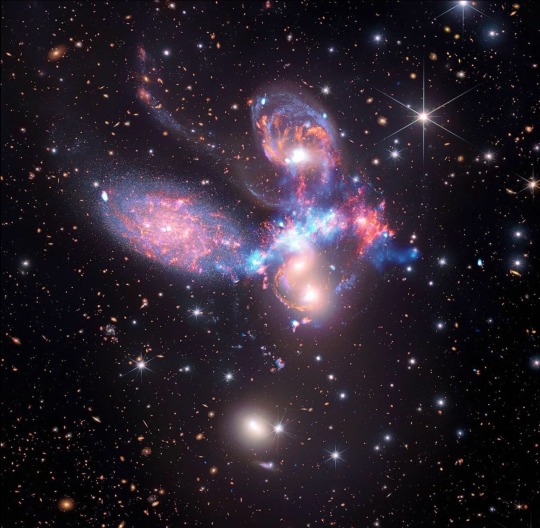
webb's infrared meets chandra's x-ray! technology is amazing <333
#nasa#jwst#james webb photos#james webb space technology#james webb update#james webb images#james webb telescope#chandra x ray observatory#space#outer space#galaxy#stars#sky#astronomy#stephan's quintet#cartwheel galaxy#deep field#carina nebula#aesthetic
958 notes
·
View notes
Text
I went with a large group of people on a vacation to the moon for a few days. It was very trippy watching the earth from space, and while looking at Stephan's quintet, I remembered being there on the moon millions of years ago doing the same thing...
359 notes
·
View notes
Text

A Quintet of Galaxies - November 15th, 1995.
"Five closely grouped galaxies are visible in this image made using the Kitt Peak National Observatory 2.1 meter telescope. The grouping is commonly known as Stephan's Quintet. Four of the galaxies show essentially the same redshift, suggesting that they are at the same distance from us. The large bluish spiral below and left of the center actually has a smaller redshift than the others, indicating it is much closer. It is probably a foreground object which happens to lie along the line of sight to the more distant galaxies. Of the four distant galaxies, three seem to be colliding, showing serious distortions due to gravitational tidal forces. The fourth is a normal appearing elliptical galaxy (at the lower right edge of the field). Collisions play an important role in the life cycles of galaxies."
#nasa#space#cosmos#universe#astronomy#astrophysics#astrophotography#stephan's quintet#galaxies#elliptical galaxy
38 notes
·
View notes
Photo
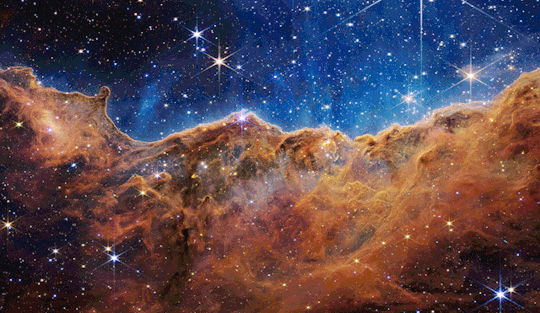
‘THE UNIVERSE AS NOBODY HAS SEEN IT YET’
IMAGES BY NASA, ESA, CSA, AND STSCI

Pictured at top, the “mountains” and “valleys” speckled with glittering stars are actually the edge of a nearby, star-forming region called NGC 3324 in the Carina Nebula. Above, Stephan’s Quintet, a visual grouping of five galaxies, is Webb’s largest image to date.
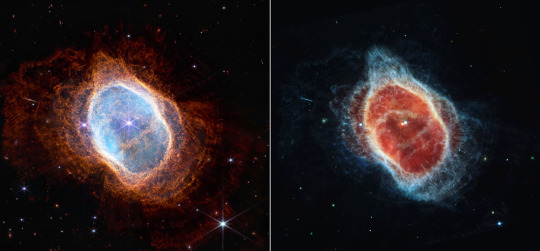
Above, a side-by-side comparison shows the Southern Ring Nebula in near-infrared light, at left, and mid-infrared light.
#space#universe#astronomy#astrophotography#nasa#esa#casa#stsci#carina nebula#stephan's quintet#galaxy#southern ring nebula#webb space telescope#national geographic
88 notes
·
View notes
Text


Now we have Stephan's Quintet. A group of five galaxies so close that some are beginning to merge! Again taken with both near and mid infered.
Source: NASA Webb Telescope
#Stephan's Quintet#NASA#space#universe#james webb#james webb space telescope#james webb telescope#science#astronomy#cosmos#magic#god#astrophotography#stars#curiosity#exploration#photography#space news#james webb update#astrophysics#jwst#hubble#earth#night sky#nebula#planet#galaxy#planets#solar system#supernova
227 notes
·
View notes
Text

This new image of Stephan's Quintet from the James Webb Telescope looks like Porygon 2. There, I said it.
#personal#shitpost#pokemon#stephan's quintet#james webb telescope#james webb images#james webb update#james webb space telescope#porygon 2
116 notes
·
View notes
Photo
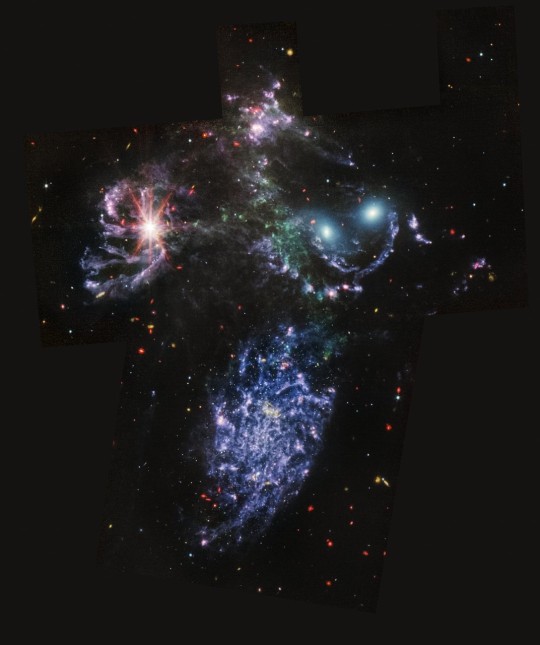
Sharpest Ever Stephan’s Quintet
94 notes
·
View notes
Text
as a kid who wanted to touch the stars only to grow up and realize all that you loved was a memory of a universe long gone, to realize how far it was from your outstretched hand, it is breath taking to hold these images in the palm of your hand ... it is enough to make a man weep
#tell me it doesnt make your heart tremble#anyway guess what my new wallpaper is#james webb space telescope#telescope#nasa#james webb#space#stars#galaxies#universe#carina nebula#stephan's quintet#human#longing
48 notes
·
View notes
Text
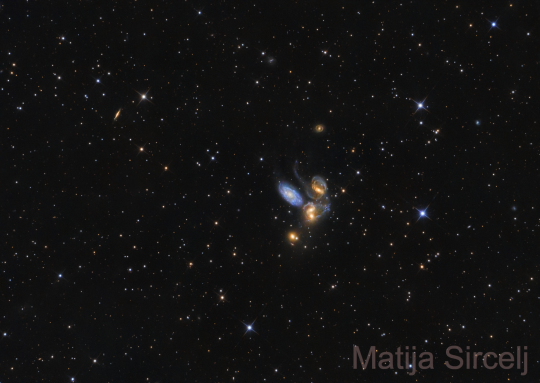
Stephan's Quintet // Matija Sircelj
#astronomy#astrophotography#galaxy group#stephan's quintet#HCG 92#galaxy#elliptical galaxy#spiral galaxy#peculiar galaxy#interacting galaxies#NGC 7317#NGC 7318#NGC 7319#NGC 7320#pegasus
69 notes
·
View notes
Text
here together
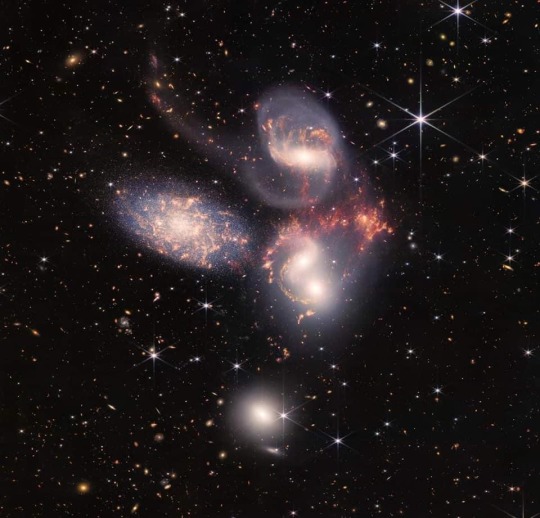
Stephan’s Quintet :: James Webb Space Telescope
* * * *
"There are many reasons to treat each other
with great tenderness. One is
the sheer miracle that we are here together
on a planet surrounded by dying stars."
~Rosemerry Wahtola Trommer
(full poem below)
On Earth, just a teaspoon of neutron star
would weigh six billion tons. Six billion tons
equals the collective weight of every animal
on earth. Including the insects. Times three.
Six billion tons sounds impossible
until I consider how it is to swallow grief—
just a teaspoon and one might as well have consumed
a neutron star. How dense it is,
how it carries inside it the memory of collapse.
How difficult it is to move then.
How impossible to believe that anything
could lift that weight.
There are many reasons to treat each other
with great tenderness. One is
the sheer miracle that we are here together
on a planet surrounded by dying stars.
One is that we cannot see what
anyone else has swallowed.
~Rosemerry Wahtola Trommer :: [h/t As She Is]
#Stephan's Quintet#James Webb Space Telescope#As She Is#Poem#Poetry#Rosemerry Wahtola Trommer#tenderness#stars
50 notes
·
View notes
Photo
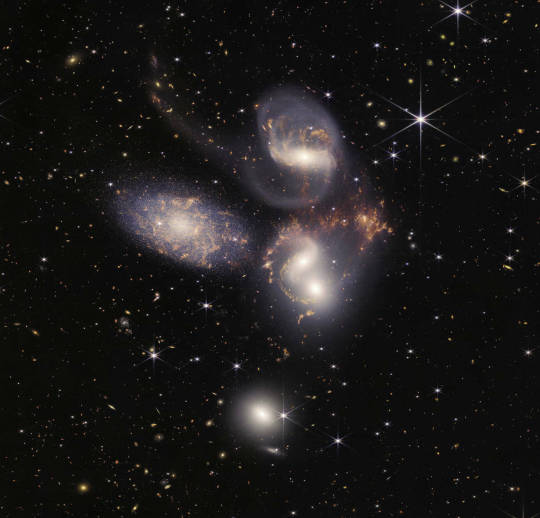
Take an interactive tour through: Stephan’s Quintet.
#Stephan's Quintet#James Webb Telescope#James Webb Space Telescope#galaxies#galaxy#space#astronomy#astrophotography#NASA#religion is a mental illness
21 notes
·
View notes
Text
Stephan's Quintet *starring* in It's a Wonderful Life (1946) / Stephan's Quintet as imaged by the Webb Telescope (2022):

#Stephan's Quintet#NASA#it's a wonderful life#it's giving me emotions#space: the final frontier#this is not the best video but look it's the best i could grab with the effort i was willing to put in to put this side by side!
21 notes
·
View notes
Text

This landscape of “mountains” and “valleys” speckled with glittering stars is actually the edge of a nearby, young, star-forming region called NGC 3324 in the Carina Nebula. Captured in infrared light by NASA’s new James Webb Space Telescope, this image reveals for the first time previously invisible areas of star birth.

The Southern Ring Nebula, also called the "Eight-Burst," is 2,000 light-years away from Earth. This large planetary nebula includes an expanding cloud of gas around a dying star.
This side-by-side comparison shows observations of the Southern Ring Nebula in near-infrared light, at left, and mid-infrared light, at right, from NASA’s Webb Telescope.

Today, NASA’s James Webb Space Telescope reveals Stephan’s Quintet, a visual grouping of five galaxies, in a new light. This enormous mosaic is Webb’s largest image to date, covering about one-fifth of the Moon’s diameter. It contains over 150 million pixels and is constructed from almost 1,000 separate image files. The information from Webb provides new insights into how galactic interactions may have driven galaxy evolution in the early universe.
This compact galaxy group, first discovered in 1787, is located 290 million light-years away in the constellation Pegasus. Four of the five galaxies in the group "are locked in a cosmic dance of repeated close encounters," according to a NASA statement.
Mark McCaughrean, the senior adviser for science and exploration at the European Space Agency, said the image shows the view from our own Milky Way to far-away galaxies — even showing the creation of new stars.
When the near-infared view is stripped away from the image, mostly gas and dust is seen. But it revealed an active black hole, according to ESA astronomer Giovanna Giardino.
“We cannot see the black hole itself, but we see the material swirling around being swallowed,” Giardino said.
#nasa#space#carina nebula#stephan's quintet#southern ring nebula#james webb telescope#james webb space telescope#I should be doing work rn but I can't stop staring at these
7 notes
·
View notes
Text
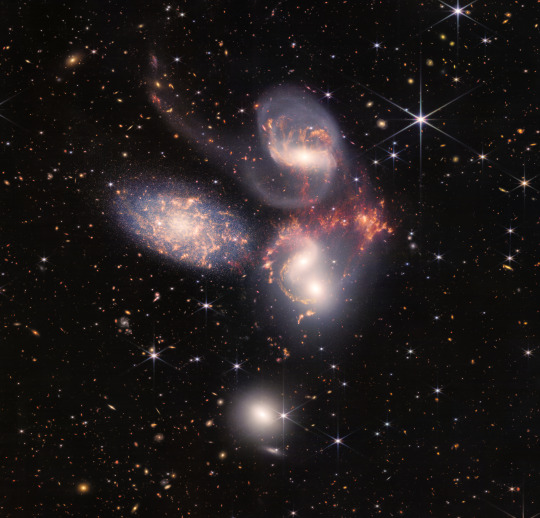
Stephan's Quintet (NIRCam and MIRI Composite)
Image and Description Source
Full Resolution PNG Download (12654 x 12132, 181.65 MB)
3 notes
·
View notes